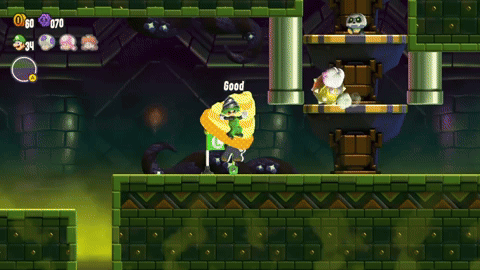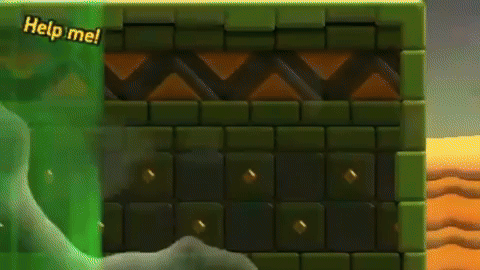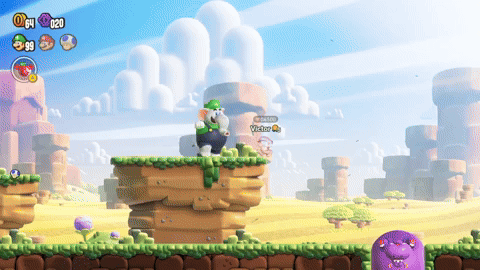Hello everyone and welcome back to another blog post. In this post we’ll be looking at the subtle online co-op systems in Super Mario Bros. Wonder. If you haven’t played it yet, you’ve been warned.
Super Mario Bros. Wonder is the newest installment in the Mario Bros series. While it does a lot to mix up the series, I’m particularly interested in the co-op systems this time around. In previous installments the game is up to four players on one screen, but in Wonder, if you have an online connection, you’re frequently accompanied by up to three random players who are making their way through the level as well.
This on its own allows the player to see how other players move, tackle puzzles, and if they travel different routes, but Nintendo takes it a couple steps further.
Players can see ghosts of online players trying to make it through.
Standee System:
Players can place standees, wooden-looking cutouts of their character, throughout the level. These appear for all players who are in that lobby.
Other online players in the same lobby can then “activate” the standee via touching it as they make progress through the level.
When a player dies, they have five seconds to move their “dead ghost” to touch an activated standee or another player to be revived.
This mechanic gets further used by players who use their standees to mark hidden blocks or routes. Since standees need to be placed on solid blocks or ground, it is easy to infer there is a hidden block underneath a floating one.
“Heart Points”
Players gain heart points for ‘friendly’ actions in the game. These points have no economic use in the game, but are displayed above player’s heads and standees, giving a rating of sorts as to how helpful they are. A notification appears in the bottom left of the screen when the action is completed that states what the action was, as well as a heart symbol briefly popping into existence above the player’s head so that they can notice it while focusing on their own progress.
There are two ways for players to gain heart points.
Reviving others.
When a player in the same lobby dies and is revived by another player/standee for the first time, it grants the helpful player heart points.
This way players who are easily making their way through levels, or are lingering behind the others, can feel good about being helpful.
Finishing together.
When players are in a level with one another, and one touches a flag pole while another is nearby, they wait on the pole for a few seconds. This allows the other players time to join them on the flag pole. A notification appears mentioning they reached the goal together as hearts appear above their heads, awarding them bonus heart points.
This further encourages players to stay near one another and help any who die so they can complete the level together.
What does all this do?
It allows players to create bonds with minimal communication and encourages cooperative gameplay. It also encourages players to stick close together, since if a player dies they can be revived by another player in the same lobby. In one particularly tough session I was paired into a level with a Blue Yoshi (player named Tommi). We both raced to the top of the level, dropping standees along the way. Over the course of 30+ lives we both kept trying and trying, helping each other out without requiring too much direct effort on our own parts. By the end of it, I was rooting for him, and I imagine he was for me since neither of us was willing to give up.
It also fits nicely into ⅔ of self determination theory.
What? How?
Competence
The points go up for assisting players.
Dropping a standee in a particularly difficult to reach area is also a way of flexing your skill to other players.
Even if a player is slower than the others, they can feel good about being the one to revive them.
Relatedness
I can put the standee on hidden platforms helping other players.
Players want to stick near one another for revives and the bonus given for completing the level together.
My standees and I can help players progress through a level.
If a player dies, and they use their ghost to reach me while I’m further along, they can skip difficult sections.
Having a high heart score means I know that person is going to take steps to help me out through a difficult level, and I’m thankful I’ve been paired up with them.
And that’s it for this week!
Do you think I missed anything? How would you tweak this system to make it fulfill all three needs in self determination theory?
I hope you enjoyed this post and I’ll see you next time. 😁
If you enjoyed this post, you’ll enjoy Signposted my game design focused newsletter. You can sign up here.








